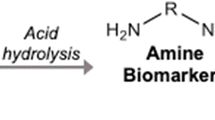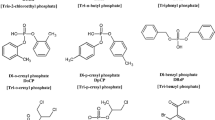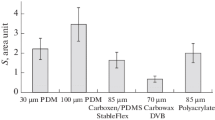Summary
The apparent amount of 2,5-hexanedione, a biomarker of n-hexane exposure in occupational health, in the urine of both exposed and non-exposed subjects varied not only as a function of the pH at which the urine sample was hydrolyzed but also depending on the capillary column used for gas chromatographic (GC) analysis of the urinary hydrolyzates after extraction with dichloromethane. The formation of a compound, identified by gas chromatography-mass spectrometry (GC-MS) as 2-acetylfuran, following acid hydrolysis was a major cause of confounding effects. This compound was hardly separated from 2,5-hexanedione on a capillary column such as DB-WAX, whereas separation could be achieved on a DB-1 capillary column. 2-Acetylfuran was formed when a urine sample was heated at a pH of < 2 for hydrolysis, and the amount detected in urine did not differ between exposed and non-exposed subjects, indicating that the formation of 2-acetylfuran is independent of n-hexane exposure. When urinary hydrolysis is used, hydrolysis at a pH of < 0.5, extraction with dichloromethane, and GC analysis on a non-polar capillary column are proposed to be the best analytical conditions for 2,5-hexanedione analysis in biological monitoring of exposure to n-hexane.
Similar content being viewed by others
References
Ahonen I, Schimberg RW (1988) 2,5-Hexanedione excretion after occupational exposure to n-hexane. Br J Ind Med 45:133–136
Dunnick JK, Graham DG, Yang RSH, Haber SB, Brown HR (1989) Thirteen-week toxicity study of n-hexane in B6C3F1 mice after inhalation exposure. Toxicology 57:163–172
Fedtke N, Bolt HM (1986a) Detection of 2,5-hexanedione in the urine of persons not exposed to n-hexane. Int Arch Occup Environ Helath 57:143–148
Fedtke N, Bolt HM (1986b) Methodological investigations on the determination of n-hexane metabolites in urine. Int Arch Occup Environ Health 57:149–158
Fedtke N, Bolt HM (1987) The relevance of 4,5-dihydroxy-2-hexanone in the excretion kinetics of n-hexane metabolites in rat and man. Arch Toxicol 61:131–137
Hirayama T, Ikeda M 61979) Applicability of carbon felt to the dosimetry of solvent vapor mixture. Am Ind Hyg Assoc J 40: 1091–1096
Inoue T, Takeuchi Y, Hisanaga N, Ono Y, Iwata M, Ogata M, Saito K, Sakurai H, Hara I, Matsushita T, Ikeda M (1983) A nationwide survey on organic solvent components in various solvent products: part I. Homogenous products such as thinners, degreasers and reagents. Ind Health 21:175–183
Iwata M, Takeuchi Y, Hisanaga N, Ono Y 1983) A study on biological monitoring of n-hexane exposure. Int Arch Occup Environ Health 51:253–260
Kasahara M, Ikeda M (1987) Spontaneous desorption of organic solvents from carbon cloth. Ind Health 25:72–81
Kawai T, Mizunuma K, Yasugi T, Uchida Y, Ikeda M (1990) The method of choice for the determination of 2,5-hexanedione as an indicator of occupational exposure to n-hexane. Int Arch Occup Environ Health 62:403–408
Kumai M, Koizumi A, Saito K, Sakurai H, Inoue T, Takeuchi Y, Hara I, Ogata M, Matsushita T, Ikeda M (1983) A nationwide survey on organic solvent components in various solvent products: part II. Heterogeneous products such as paints, inks and adhesives. Ind Health 21:185–197
Mutti A, Falzoi M, Lucertini S, Arfini G, Zignani M, Lombardi S, Francini I (1984) n-Hexane metabolism in occupationally exposed workers. Br J Ind Med 4:533–538
Nyén P, Ebendal T, Erksdotter-Nilsson M, Hansson T, Henschen A, Johnson A-C, Kronevi T, Kvist U, Sjöstrand NO, Höglund G, Olson L (1989) Testicular atrophy and loss of nerve growth factor-immunoreactive germ cell line in rats exposed to n-hexane and a protective effect of simultaneous exposure to toluene or xylene. Arch Toxicol 63:296–307
Perbellini L, Brugnone F, Pastorello G, Grigolini L (1979) Urinary excretion of n-hexane metabolites in rats and humans. Int Arch Occup Environ Health 42:349–354
Perbellini L, Burgnone F, Faggionato G (1981) Urinary excretion of the metabolites of n-hexane and its isomers during occupational exposure. Br J Ind Med 38:20–26
Shibata E, Huang J, Hisanaga N, Iwata M, Saito I, Takeuchi Y (1990) Changes in urinary n-hexane metabolites by co-exposure to various concentrations of methyl ethyl ketone and fixed n-hexane levels. Arch Toxicol 64:165–168
Author information
Authors and Affiliations
Rights and permissions
About this article
Cite this article
Kawai, T., Yasugi, T., Mizunuma, K. et al. 2-Acetylfuran, a confounder in urinalysis for 2,5-hexanedione as an n-hexane exposure indicator. Int. Arch Occup Environ Heath 63, 213–219 (1991). https://doi.org/10.1007/BF00381571
Received:
Accepted:
Issue Date:
DOI: https://doi.org/10.1007/BF00381571




